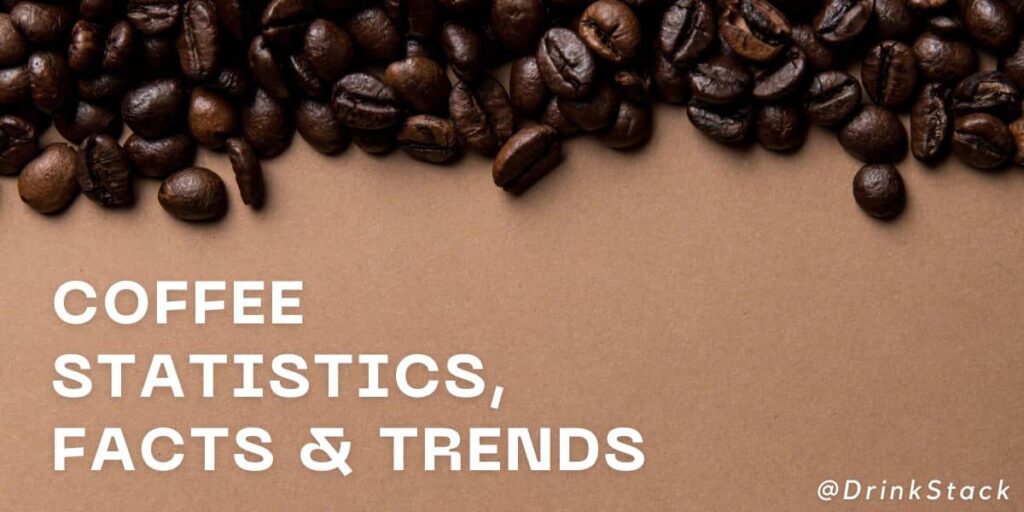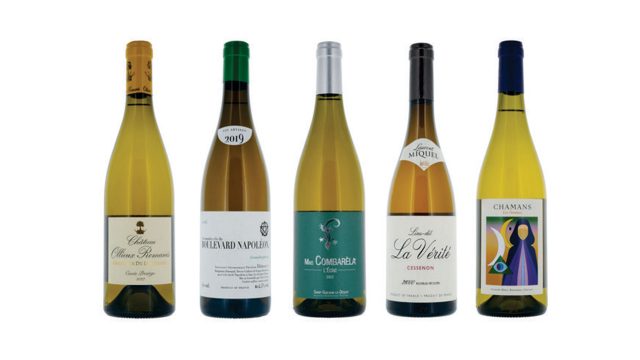Coffee Statistics & Facts For 2024

The world of coffee is expansive and always evolving, and one of the best ways to better understand larger coffee trends is to take a look at coffee statistics.
In this article, we will take a deeper dive into the numbers when it comes to coffee production and consumption statistics by country. We will also highlight some of the top-selling coffee brands and most successful coffee chains on earth, and take a closer look at the statistics behind each.
Coffee Statistics For 2024
Coffee Production Statistics by Country
In some countries, coffee is an extremely important part of the national economy, and some areas around the globe are particularly well suited for coffee production due to ideal climates and growing conditions. According to the most recent available data, coffee production is increasing each year, and shows no signs of slowing down any time soon!
Brazil – 2,652,000 Metric Tons per Year
It comes as no surprise to most coffee enthusiasts that Brazil finds itself atop the list for coffee production and exportation on a yearly basis. Brazilian coffee beans can be found just about anywhere coffee is sold, and their quality ranges from everyday roasts to some of the top coffee selections in the world.
While Brazil has been a powerhouse in the coffee industry for many decades, there have been shifts in recent years regarding how coffee beans are grown and farmed. There has been a significant push towards increased sustainability, as well as more ethical business practices.
Vietnam – 1,650,000 Metric Tons per Year
While Brazil leads the way in terms of both overall production and production of high-quality Arabica beans, Vietnam is the world’s largest producer of Robusta beans. Robusta coffee beans are generally considered to be lower in quality and flavor, though they can contain up to three times the amount of caffeine as Arabica beans.
A huge chunk of coffee production in the country of Vietnam is dedicated to instant coffee, which is generally consumed with sugar and sweetened condensed milk. 3 in 1 coffee is one of the most popular Vietnamese coffee styles, and it contains instant coffee as well as powdered condensed milk and sugar.
Colombia – 810,000 Metric Tons per Year

Colombia is best known for producing high-quality and extremely flavorful Arabica beans that are grown at different elevations along the Andes mountain range. There is also a local focus on sustainability, as the country has learned from many of Brazil’s mistakes in terms of deforestation.
The coffee that is grown in Columbia generally carries a sweet and nutty flavor profile, and the majority of Colombian coffee beans are both hand-harvested and sun-dried. It is readily available in most places coffee is sold, and even major brands like Amazon have begun private labeling quality Colombian coffee.
Indonesia – 660,000 Metric Tons per Year
One of the main things that separate coffee from Indonesia apart from other coffee styles around the world is the fact that the beans are processed using the “wet-hulled” method. This results in a very unique tasting profile.
Indonesian coffee is generally fairly low in acidity, though it makes up for this with elevated flavors with spicy notes. Like Vietnamese coffee, it is generally enjoyed with sweetened condensed milk and sugar and is available for purchase through many online outlets.
Ethiopia – 384,000 Metric Tons per Year
At 384 thousand metric tons of coffee exported per year, Ethiopia finds itself at fifth in the worldwide rankings, with both Honduras and India not far behind at 348 thousand metric tons each. Ethiopia is considered to be the birthplace of coffee, and it is best known for the production of high-quality Arabica beans.
Coffee from Ethiopia is generally grown, farmed, and dried using traditional methods, and can vary in terms of flavor profile widely depending on which region it is from. The Yirgacheffe Region is one of the most famous and sought-after areas of production in the country, and it is well known for its clean and bold flavors.
Coffee Consumption Statistics by Volume

In this section, we will take a closer look at which countries around the globe are responsible for consuming the most coffee, by volume. It is important to point out that the “per capita” statistics look very different, as some smaller countries with very cold climates like Finland and Norway consume a very high amount of coffee beans relative to their total population.
United States – 26,651,000 Bags per Year
The coffee tradition in the US dates back hundreds of years, and today it is an important part of life all the way from New York City to Los Angeles. The United States consistently finds itself atop the list for total coffee consumption year after year, and there are no signs of this statistic changing any time soon.
Brazil – 22,000,000 Bags per Year
Brazil is one of the most “coffee-centric” countries in the entire world, finding itself both in first place for total coffee production, and second place for total coffee consumption. The rainforest climates of Brazil are essentially ideal for high-quality Arabica bean growth, and Brazilians have been enjoying some of the best coffee on earth for centuries.
Germany – 8,670,000 Bags per Year
Germany has long been the leading European country in terms of overall coffee consumption, and it is an important part of German life for everyone from businessmen to construction workers. German coffee is often served with a small cookie or biscuit and is usually served as less bitter than coffee in other parts of the world.
Japan – 7,355,000 Bags per Year
The coffee culture in Japan is heavily influenced by Western coffee culture, and the country has gained a fair amount of recognition over the past several decades for the production of high-quality and unique pour-over coffee devices and filters.
France – 6,192,000 Bags per Year
Coffee in France is often enjoyed with a croissant or other pastry for breakfast, and it is typically stronger and more bitter compared to coffee in other countries. It is often served in much smaller cups compared to other parts of the world, and espresso-based beverages are also popular.
Top Selling Coffee Brands

While there has been a significant shift towards supporting local businesses and coffee shops recently, large coffee chains are still very successful all across the world. Many of these brands have become synonymous with coffee for some, and most are available for both at-home and in-store coffee experiences.
Starbucks – 26.5 Billion in Annual Revenue
Founded in 1971 in Seattle, Washington, Starbucks has grown into a “coffee giant” and is by far the most successful and prominent coffee brand worldwide. They employ nearly 350 thousand people and have locations in over 70 countries.
McCafé – 21 Billion in Annual Revenue
McCafé is the coffee branch of the McDonald’s company, and they have expanded in terms of both popularity and selection over the years. Today, McCafé coffee drinks are available at nearly all McDonald’s locations, as well as at home in coffee bean and single-serve coffee pod format.
Tim Hortons – 3 Billion in Annual Revenue
Tim Hortons is a Canadian powerhouse chain of fast-food restaurants that is extremely beloved and well-known for its coffee selections. One of the most popular Tim Hortons orders is the “double-double” which is a drip coffee mixed with two creams and two sugars.
Costa Coffee – 1.5 Billion in Annual Revenue
Costa Coffee is a UK-based subsidiary of The Coca-Cola Company that now has locations in over 30 different countries. They employ over 18 thousand people, and one of the most popular orders at Costa Coffee is the “Mocha with Cream.”
Dunkin – 1.3 Billion in Annual Revenue
Dunkin, formerly known as Dunkin Doughnuts, is an American fast-service coffee restaurant that is extremely popular on the East Coast. They have now expanded to over 40 countries, and they have one of the most downloaded apps outside of the Starbucks company.
Coffee Statistics – A Market Overview

Consumers
Coffee consumers today are more involved and informed than they’ve ever been. This is a far cry from just a few decades prior.
They want to know not just where the coffee comes from, but how it’s made. What methods are used in its growing, cultivation, and roasting process? Whether or not ethical pricing is a priority. Even specialty instant coffee, often treated as the antithesis to quality, is seeing a spike in today’s stressed and tired population. The coffee drinker of today is transforming into a major factor for where the coffee industry will go tomorrow.
- Over two billion cups of coffee are consumed daily.
- Nearly 40% of Millennials drink gourmet coffee regularly.
- 30% of Generation Z drink gourmet coffee regularly.
- Coffee prices have increased by 20%.
- Americans drink an average of two cups of coffee per day, with nearly 30% drinking at least two cups at home per week.
- The instant coffee market is expected to grow by 11.5% between 2020 and 2025.
- Around 53% of the American coffee drinking population wants to drink coffee that’s ethically produced and good for the environment.
- A 2020 UK coffee survey found 77% of customers view bad tasting coffee as ‘discouraging’ as poor customer service.
- At least 75% of UK customers want more transparency in the coffee industry.
- Around 12% of UK customers believe drone technology is the future of delivery.
Baristas
The face of the coffee industry is the barista. They range from recent high schoolers to full-time college students with children.
Their hands already full juggling customer service with food preparation, the barista has seen many colorful (and unpleasant) events during the coronavirus. From cafe customers threatening lawsuits after refusing to wear masks to coffee shops defying social distancing orders, being a barista is far from the romantic part-time it’s painted to be. There have been several initiatives set up to celebrate the art of being a barista, aiming to improve not just their skills, but their working conditions. After a few years of working as a barista myself, I’m personally hoping to see things improve as soon as possible.
- There are 15.6 million restaurant workers in the United States.
- The same UK coffee survey above saw a majority 90% of customers wanting cafe staff to be paid a more competitive wage.
- A petition was created early in the year to support baristas and cafes, including unemployment relief, mortgage deferment, and loan deferment.
- Baristas from Onyx Coffee Lab claimed the top spot at the 2020 US Cup Championship.
- The Melbourne International Coffee Expo has been canceled for safety reasons, which includes the World Barista and Brewers Cup championships.
- Several Starbucks employees across the nation opposed the company’s order to stay open during the height of the coronavirus.
Farmers
One of the biggest issues facing the global coffee industry is the widespread low pay and poor working conditions of coffee farmers.
Coffee prices, with rare exceptions, have remained far too low to keep farmers’ livelihoods viable. It’s such a significant problem that coffee-growing families actively encourage their own to seek out different industries, such as this illuminating Forbes interview with fifth-generation Colombian coffee farmer Maria Palacio. The global pandemic, predictably, has made these issues ten times worse. The first step toward meaningful change is knowledge, of which is becoming more accessible to consumers every day.
- World coffee production has shrunk by nearly 2.5 million bags due to the pandemic.
- Honduras has lost over 900,000 bags to coffee rust damage.
- Mexico has lost 850,000 bags due to poor yields.
- Discouraged by low prices, some Vietnamese farmers are instead planting mango, durian, or avocado trees instead of coffee.
- There are roughly 1.7 million coffee farmers working in Uganda, Africa’s largest coffee exporter.
- An HRNS survey revealed 65% of this year’s coffee farmers are unable to access their farm labor due to COVID-19.
- ICO recently canceled its 126th session of the International Coffee Council for safety reasons, in spite of mounting needs for collective organizing.
- Ethiopian coffee farms have discovered altitude is a major contributor to coffee rust.
Roasters
Roasteries are very popular in the United States. It’s an average month when I hear about one opening up or expanding.
That makes it a highly competitive industry at the best of times. Thanks to COVID-19, the outlook for roasteries has grown uncertain. Several have had no choice but to close down for good, with others pivoting to online models and local delivery to stay afloat. That’s not to say roasteries and roaster-cafes are down and out. Global demand for coffee is as high as it’s ever been, particularly with the increase in homebrewing and growing consumer awareness of the coffee industry’s inner workings.
- The American roasting market is expected to grow by 10.3% between 2020 and 2025.
- The global coffee roasting market has a projected CAGR of 6.2% between 2019 and 2024.
- The South Korean coffee market is expected to grow by 10.9% CAGR between 2020 and 2025.
- The growing consumer demand for ‘fresh and aromatic’ specialty coffee is considered a major point in favor of roasters.
- Today’s top five roasting countries by revenue are the United States, Brazil, Canada, Germany and Italy.
- 1000 Faces Coffee, Beanstock Coffee, and Klatch Coffee are just a few of the coffee roasting companies to win the 2020 Good Food Award for both phenomenal coffee and fair pricing standards.
- Mostra Coffee wins 2020 Micro Roaster Of The Year.
- Coffee By Design wins 2020 Macro Roaster Of The Year.
Importers And Exporters
Deciding where the coffee goes is a full-time job in itself.
Do you sell quality green coffee beans to small-batch roasters or grocery store outlets? Which origin will yield the biggest profits against temperature changes and coffee rust? Why do some countries prefer specialty and others prefer instant? These decisions aren’t made overnight. They involve a plethora of scientific advances and old-fashioned methods, all the better to target specific markets with unique needs.
There’s no one-size-fits-all approach with coffee: diversity in both approach and target audience is key to ensuring the industry can flourish in the future.
- Global coffee production has reached 170 million 60 kilogram bags.
- Coffee is the second largest commodity traded worldwide.
- Brazil is the leading producer and exporter of coffee, followed by Vietnam and Colombia.
- The United States, Germany, and France are the largest importers of coffee worldwide.
- China has seen a spike in green coffee bean purchases, with 2019 and 2020 both predicting an average of 900,000 60 kilogram bags imported.
- Green coffee prices have seen a steady increase in August of 2020.
- At least 70% of coffee-producing countries predict a decrease in household coffee income throughout 2020.
- Reduce in global trade has caused Brazilian coffee farms to lose valuable shipping containers in their harbors.
- Nespresso is seeking to increase single-origin Ugandan coffee production.
Cafes And Coffee Culture

Lifestyle is a huge part of the coffee drinking experience.
Before the pandemic cafes were a beloved spot to mingle, work, and enjoy live art. Many coffee drinkers enjoy brewing at home, too, and this method is now considered a much safer way to get a fix. A popular coffee recipe earlier in 2020 was dalgona: popularized in South Korea, it took the internet by storm for its accessibility, charming texture, and fun recipes. While trends come and go, staples are forever. Many Americans are eager to return to their normal, even though normal is a standard that should adapt, too.
-
- There are currently over 15,000 Starbucks cafes in the United States.
- Luckin Coffee, a Chinese ‘Starbucks competitor’, faced a massive scandal that could see it shut down for good before 2021.
- Blue Bottle Coffee closed its 71 American stores in March due to the pandemic.
- 62% of Americans own a drip coffee machine.
- Nearly 30% of Americans drink instant coffee.
- Less than 5% of Americans use a pourover.
- Millennials are becoming a prime cold brew market.
- A 2020-2024 cold brew forecast predicts a global CAGR of 28%.
- The bubble tea market, a major coffee competitor, has an average CAGR of 8.09% and is expected to hit $3.49 billion in a 2019-2026 global market projection.
Arabica
The most in-demand coffee bean, by far, is arabica.
Prized for its lower caffeine content and subtle range of flavors, it is the bean of choice for many roasters, cafes, and restaurants. Unfortunately, it is also facing several obstacles environmentally. Coffee cherries require a strict set of parameters to grow. This includes (but isn’t limited to) altitude, soil quality, temperature, surrounding trees, and timing. Climate change has thrown a wrench in that delicate balance, forcing farms to throw out bags or leave their livelihood in search of greener pastures.
- Brazil, Colombia, and Ethiopia are today’s leading Arabica producers.
- Arabica has seen its lowest prices in the past decade.
- Arabica production has seen a dip in production, facing a 0.9% dip since last year and expected to decrease by 4.1%.
- Current prices for Arabica beans go for 2.93 per kilogram, expected to increase to 3.09 per kilogram by 2025.
- 60 of the 124 coffee plant species are facing extinction.
- Wild Arabica plants are classified as threatened under climate change specifications.
- Coffee’s natural population will shrink by 50% in 2088.
Robusta
While not as coveted as arabica, robusta succeeds through quantity.
Its higher caffeine content and perceived lower-quality make it ideal for commodity coffee, such as instant coffee crystals, travel coffee, and coffee supplements. Several countries in Africa and Asia also prefer it for its lower price and accessibility. There is currently an ongoing debate about the veracity of robusta against climate change, with some arguing for its more durable nature toward coffee rust and others stressing it’s still as susceptible as arabica. The growing demand for specialty robusta will see this bean having its reputation transformed sooner rather than later.
- Vietnam is the largest producer of robusta coffee, followed closely by Brazil.
- Where arabica production has declined, global robusta production is expected to increase by 3.7% by the end of 2020.
- Despite increasing demand, robusta prices are expected to decline from 1.87 per kilogram to 1.73 per kilogram.
- Global robusta coffee production has reached 73 million 60 kilogram bags.
- Robusta coffee is expected to well exceed 74 million 60 kilogram bags next year.
- Brazilian robusta production has increased by 27.2% from 2019 to 2020.
- Rise in robusta demand is expected to increase coffee prices by 16%
- The Perfect Daily Grind explored in 2019 the growing need for unique specialty robusta coffee standards.
Technology
Coffee is highly complex not just in the soil, but outside of it.
2020 is a year of innovation against the odds. Online coffee subscriptions have filled in the gap left by empty cafes and restaurants, complying with social distancing measures while still pulling in sales. Creative products are ensuring farmers stay employed while still providing consumers with quality goods, such as the health-focused coffee leaf tea from Wize. Ideally, coffee technology will continue to target major weaknesses in the industry, helping everyone in the pipeline stay on the same page.
- Atomo Coffee is a start-up creating ‘beanless coffee’, raising $9 million for a new facility in Seattle.
- Online grocery sales are expected to reach $100 billion by 2025.
- Coffee is one of the leading e-commerce boosts in 2020, boasting an impressive 38.6% CAGR on Amazon alone.
- Amazon is home to nearly 600 different brands of coffee capsules and pods.
- American coffee subscription sales went up by 109% between March and April.
- Blue Bottle Coffee saw a 150% increase in e-commerce sales after mass closing its stores at the beginning of 2020.
- Peet’s premium bag sales by 33% from the same period in 2019.
- Bellwether Coffee received $58.2 million in funding to create a carbon-free roasting system to reduce coffee roasters’ environmental footprint.
- South Korean cafes are turning to robot baristas to help with social distancing.
Climate Change

Adapting is necessary in a world seemingly defined by massive wildfires, rising temperatures, and struggling crops. That doesn’t mean these figures shouldn’t be reduced.
The coffee industry is beset by problems that only seem to get worse by the day. When it’s not coffee rust killing plants outright, it’s insects that are thriving in warmer temperatures. Farmers are doing their best to adapt with generations worth of knowledge, already an uphill battle due to their scarce resources and mounting debt challenges. Major responsibility lies not just in changing everyday behavior, but in corporate activity: just 100 companies are responsible for over 70% of major global emissions.
- Climate change has warmed the global temperature by 1.1 degrees Celsius since the Industrial Revolution.
- Wild arabica could shift from threatened to extinct by the end of the century due to greenhouse gas emissions.
- Cocoa is predicted to become a more viable crop if arabica dries up.
- Premature and extended rains in 2019 have left Ethiopian farmers in a difficult harvesting spot for 2020.
- The CIAT has estimated half of the world’s coffee-producing land will be unsuitable by 2050.
- An illuminating 2018 Time article revealed the coffee industry would need at least $100 million in funding per year to adapt to climate change obstacles.
- ‘Hybrid vigor’, the act of breeding coffee plants to create more durable varieties, is a major focus for scientists in 2020.
Eco-Friendly Developments
How is the global coffee industry combating climate change? Let’s count the ways.
Each bag of coffee often comes with proposals to make the world a better place. Some bear the USDA brand, designed to ensure the coffee is made with organic methods that circumvent pollution. Others are bird-friendly or made out of recyclable paper. This year has seen multiple eco-friendly initiatives proposed, with a few already in the works to (hopefully) make next year more bearable. Ideally, all of these elements will come together to keep costs low, people housed, and coffee quality high.
- The AF&PA predicts a paper recovery rate of at least 70% for the United States.
- The USDA is proposing an update in 2020 to its eco-friendly regulations due to widespread misinformation and lack of professional oversight.
- Keurig, well-known for its coffee pods, is facing a lawsuit for allegedly misrepresenting how recyclable their products are.
- Recycled coffee grounds are found to help robots better navigate uneven terrain.
- A UK start-up has transformed coffee grounds into a healthier fuel alternative.
- Bio Bean is making waves with their new recycled coffee ground logs, helping to reuse waste and reduce deforestation.
- The Coffee Technology Expo of 2019 was pushed to 2020, with a focus on next-generation technology and equipment for the supply chain.
Eco-Friendly Developments
Much like wine and tea, the packaging of coffee is often focused on sustainability.
The work that goes into making supplies is just as important as the supplies themselves. As explored above, coffee packaging is keen to make it clear just how far a consumer’s dollar travels. The complicated expenses that go into crafting coffee and its plethora of accessories, though…bears a more scrutinizing look. With so much already balancing on a razor’s edge, it’s not enough to promise good. With so much room for improvement in the coffee pipeline, some of this responsibility inevitably falls on the shoulders of everyday buyers.
- A staggering 600 billion disposable cups fill global landfills yearly.
- Colombier BioBarrier Coating has introduced a biodegradable coating to replace incompatible plastic liners.
- Britain goes through 2.5 billion coffee cups per year.
- An estimated 1 out of 400 coffee cups are recycled.
- Single-use coffee supplies were falling out of favor to reduce waste. They’ve made a comeback in 2020 to reduce the spread of coronavirus.
- Recyclable coffee bags are predicted to remain a big selling point in the future from 2018’s SCA Expo.
- The original creator of the Moka pot’s bankruptcy filing in 2018 has created concern for the coffee creation’s success in the future.
Marketing
What could speak to one customer personally could turn another off. So lies the double-edged sword of the coffee marketing machine.
Effective marketing means understanding precisely what makes certain groups of people tick. Older coffee-drinking generations were often more concerned with price than ethical purchases. Millennials and Gen X, on the other hand, are growing increasingly aware of the pitfalls of the coffee supply chain. Vox’s recent video on the global coffee crisis explores the changes on the consumer end of things and what that could mean for the next few years.
- Forrester found customers watch videos up to 20 times longer than on-demand content like movies or shows.
- Nearly 294 billion emails are sent and received every day, with this figure expected to increase to 347 billion by 2022.
- Email marketing boasts an average of $42 for every $1 spent.
- Nearly 50% of customers want to receive emails from their favorite businesses on a weekly basis.
- Panera Bread has seen over 800,000 new sign-ups for its coffee subscription program.
- There has been a 109% increase in American coffee subscription sales and an 11% increase in coffee equipment sales.
- Stumptown saw a whopping 250% increase in online coffee sales after closing several stores earlier this year.
- The 2020 SCA Expo in Portland was canceled for safety concerns, with the Specialty Coffee Expo in New Orleans postponed from early 2021 to later in the fall.
It can feel impossible to keep up.
Turn to the left and you see a wildfire ruining months of hard work. Turn to the right and you see coffee companies losing trust for unethical practices. What keeps me optimistic is that we all have our part to play. Some have strengths in agriculture, while others focus on engineering. As a copywriter, I’m invested in working with coffee businesses that put in the vital work behind-the-scenes.
If you know someone getting into coffee, or who wants to make informed decisions, link them to this list. In the meantime: what do you take into account when buying coffee?
Final Thoughts
The world of coffee is always changing and evolving, but keeping up with the most important coffee statistics is a great way to stay informed on the latest coffee trends. Feel free to leave a comment below if you know of any interesting coffee-based figures or statistics, and be sure to let other coffee lovers know which statistics you find to be most interesting!




